Children Dentistry
TOPICS
- Preventive Child Dentistry
- Cavity and Fillings
- Pedo RCT and Pedo Crowns
- Space Maintainers:
- Oral Habits and Habit Breaking Appliances
The importance of primary teeth in the jaws of small children will be understood when the teeth are lost for some reason. Appliances such as space maintainers are recommended to prevent migration of other teeth in the empty spaces, otherwise the status of future permanent teeth (due to erupt after few years) will be in jeopardy and thus cause irregularities in the jaws.
Prevention: Various aspects of Preventive Children Dentistry are :
- Dietary and Nutritional Counselling: Diet and Nutritional Counselling, Food Habbits play a very important role in dental decay formation. It includes sugar exposures, avoiding Sticky Foods like chocolates and biscuits, in-between meal snacking, caries risk, concept of tooth friendly foods etc.
- Importance of Oral Hygiene: Use a finger brush when a few teeth start to erupt and when more teeth start to erupt a low fluoride toothpaste (meant specially for kids) which is having about 500 ppm fluoride now widely available in markets should be used.
- Brushing & Flossing: Brushing and flossing everyday will help keep your teeth and gums Proper brushing techniques for children are taught at our Clinic
- Topical Fluoride Application: Fluoride ion makes teeth harder and more resistant to acid attack and also disables the bacterial acid synthesis which is a precursor for cavities. Topically means delivering fluoride on the teeth through gels, foam, varnishes, toothpastes, mouthwashes etc. This way they replace certain ions and makes teeth stronger and prevents future decay. Fluoride can be attained at home by using fluoridated mouthwashes and toothpastes or in the dental office by gels, varnishes and foams.
- Pit & Fissure Sealants: A sealant is a protective plastic coating which is applied on the biting surfaces of teeth. The sealant prevents food debris and bacteria from depositing into grooves of teeth thus prevents Tooth decay.
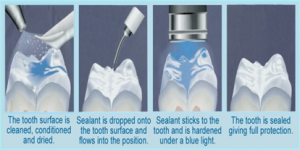
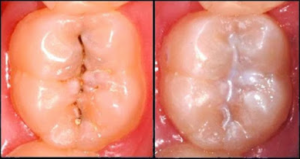
- Enamel Improving Creams (Tooth Mousse): Certain oral creams contain Casein and Phosphopeptide (CCP Protein) which holds calcium phosphate which is necessary for natural remineralisation of tooth enamel. These tooth mousses replenish the mineral stores of enamel by delivering bioavailable calcium and phosphate.
Preventing baby bottle tooth decay
- Do not permit your child to nurse passively on the breast or bottle while sleeping.
- Do encourage your baby to use a beaker or cup as soon as he can (usually at about 6 months) and in any case as soon as the first tooth appears
- Try not to use a bottle as a pacifier. However, if you must use a bottle to calm your baby at sleep time, fill it only with water
- Do not add sugar or any solids to your baby’s bottle, or dip the teat or pacifier into sweet substances such as honey, jam etc.
- Do not leave your baby sipping from a bottle or cup for long periods. Encourage him to drink what is needed and discard the rest
- Your child should be weaned from breast / bottle to a cup and solid foods introduced in his diet by 1st birthday. This is a critical time in your teaching your child to eat healthy foods
- Do not use bottle after 12 months unless advised by a health professional
CAVITY AND FILLINGS
Fillings and Restorations: Children’s teeth will require treatment once decay sets in. The decayed portion of the teeth is meticulously removed from the tooth structure which then requires to be restored using filling materials. Various types of filling materials have been invented and used since ages. The popular silver amalgam fillings are now getting out- favoured by newer materials with better properties
With the recent advacnces the newer materials used in the Pediatric Dentistry are:
- Glass Inomers and Resin Modified Glass Inomers
- Composite Resins
Both are tooth coloured White Fillings and sometimes multicoloured filings are used for Novelty Effect. Filling and restorative processes are generally painless but deeper and extensively decayed teeth treatment might just get a little discomforting requiring local anesthesia. With the advent of very thin, almost hairlike needles meant for local anesthesia, even the numbing process is getting increasingly acceptable for young kids.
|
Pedo RCT and Pedo Crowns :
Why root canal in milk teeth? : Whenever the milk teeth get infected with deeper cavities and if the inner nerves are involved they can be treated by Root Canal Treatment. With the help of clinical examination and x-rays it can be decided if root canal is needed or not. If that particular tooth has still some time to go before their actual time of falling off, then it is advisable to retain that tooth by doing a root canal. In this procedure we remove all the infected pulp (nerves) from within the tooth, clean the canals and fill them up with specially formulated materials. These materials are designed to be dissolved while the body is naturally reabsorbing the root in preparation of the tooth falling out to be replaced by permanent tooth later on in life. IMPORTANT: Milk teeth and permanent teeth are two separate entities. The nerves of the milk teeth have no relation to the nerves of the permanent teeth. Therefore, doing a root canal treatment in milk teeth DOES NOT damage the permanent teeth formation. On the other hand by not doing a root canal in the decayed milk teeth, damage to the permanent tooth development may occur. The infection and the pus of the primary tooth can spread beyond their roots and damage the structure and eruption path of the developing underlying permanent tooth. THE BENEFIT: Once the RC is done, the tooth is saved and brought back to a pain free and functional condition and this then serves the function for the child till they fall off naturally which is most desirable. We perform this procedure in ONE SITTING rather than call your child again and again. This way it becomes very much acceptable to the child. However if the child is brought late to the dentist and the swelling, pus formation, gum boil or an abscess has already occurred in connection with the damaged tooth then more sittings may be needed. |
||
PEDO CROWNS: Crowns are meant for complete coverage of extensively damaged teeth which are not possible to restore with fillings alone. Mostly stainless steel (SS) crowns or sometimes acrylic posterior crowns are used for primary as well as young permanent teeth. These preformed SS crowns offer full coverage over the tooth structure leaving no chance for secondary decay formation. Various crown sizes are available for each and every teeth, thus correct crown selection is done which are then fitted over the teeth in their proper positions, all in one sitting. Same is the case for anterior teeth, wherein strip crowns, polycarbonate crowns or SS crowns with tooth coloured facings are used. These crowns are relatively pliable, don’t fracture and maintain a snug fit during entire growth and development and movement of the jaws. The crowns are indicated especially after root canal treatment, over hypoplastic teeth and over badly broken down eroded teeth. These crowns also resist erosion and enhance the vertical height of the teeth.
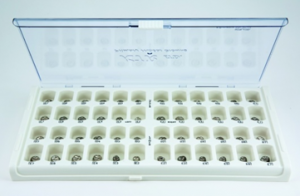
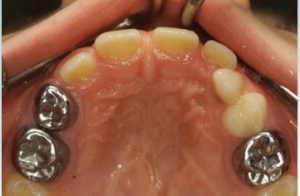
Space Management And Space Maintainers:
The milk teeth are ideally designed to fall off at regular intervals from between 6 to 12 years of age, so that new teeth can erupt turn by turn sequentially into their proper positions. But if the milk teeth are lost or removed prematurely the new teeth are only going to erupt at their destined time. Therefore space has to be maintained to prevent problems of irregularities and abnormal eruptions of permanent teeth from occurring. This can be done by using appliances known as space maintainers. It is always sensible to keep teeth in normal positions with a space maintainer which is comfortable, easy and far less expensive than with a major orthodontic treatment to move the teeth back in place. A space maintainer is a appliance that “holds” the space until a new tooth grows in and prevents the teeth from moving toward empty spaces in the mouth
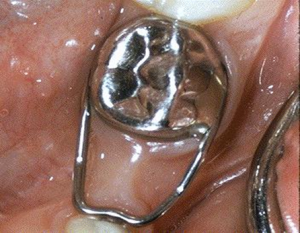
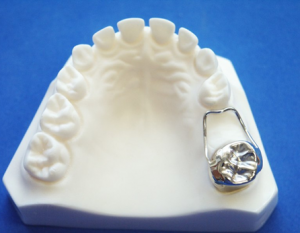
Oral Habits And Habit Breaking Appliances: Many oral habits like lip biting, thumb sucking, tongue thrusting, mouth breathing, lip and digit sucking etc. which can be considered normal in infants do produce deleterious and undesirable changes in the facial and oral profiles of children. A variety of treatment and psychological counseling options are imparted towards arresting such habits, correcting deformities in their initial stages and bringing back the perfect pleasing features you would like to have on your child. |
THUMB SUCKING HABIT BREAKING APPLIANCE
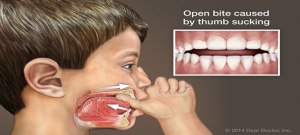
Thumb sucking is a natural phenomenon of a child’s reflexes which gives them comfort and mind relaxation. However during frontal teeth eruption this activity in a child must stop. Generally, children stop thumb sucking between 2-4 years. But if it continues for long, it has its own disadvantage like:
- Improper growth of the mouth.
- Misaligned teeth.
- Decelerated mental growth.
A specially designed appliance known as crib has semicircular wires of stainless steel which are tied to molars using steel bands. This crib stays unaffected while eating and is comfortable to a child as they are barely visible. This will gradually impact thumb sucking habit of the child to stop within few weeks or months. After the habit is cured this crib is removed and is can be reused if the habit restarts.
TONGUE THRUST HABIT BREAKING APPLIANCE
Tongue thrusting refers to as keeping the tongue in an incorrect position while swallowing. Incorrect position of the tongue creates immense pressure on the teeth which forces misalignment per swallow. Also, nervous thrusting pushes the tongue while at rest against the teeth. This is a difficult habit to break. Hence we design an appliance that can be permanently cemented in that place where the tongue exerts pressure. Before any orthodontic treatment, this habit is to be cured compulsorily.
